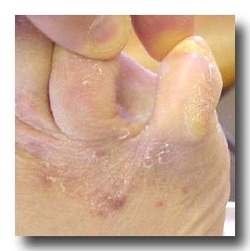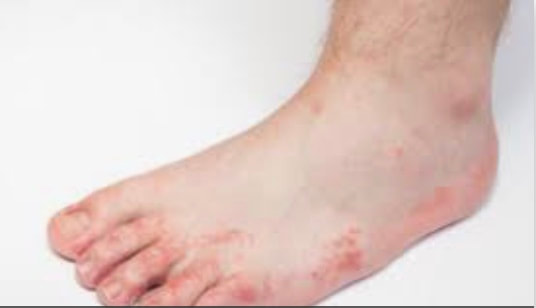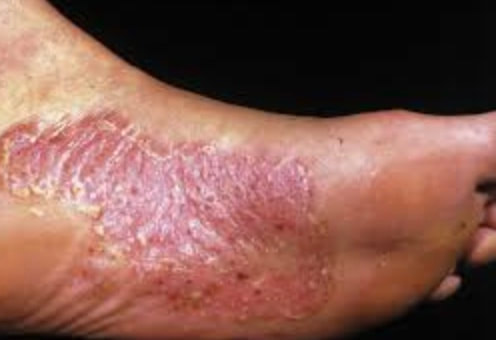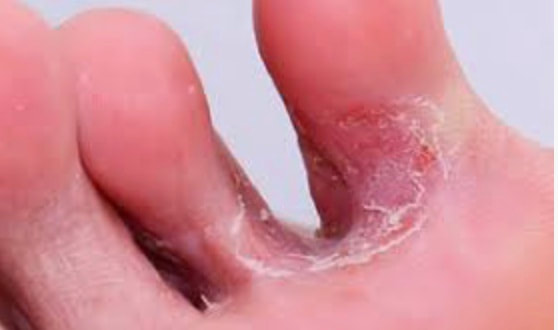ATHLETES foot

Athlete's Foot is the most common term to describe a fungus condition involving the skin of the feet and toes. Another term is Tinea Pedis. However, that means a ringworm type infection and the term is misleading, since the organisms that cause it are not worms, but are fungus spores technically known as dermatophytes. A more appropriate name is Dermatophytosis. The three names above really mean the same thing.
The patient first notices an itching sensation, usually between the toes. The skin in that area may have small blisters and be peeling. (Figure left) a less itchy form of Athlete's Foot can appear as a dry, red peeling condition on the bottom of the foot.
How Does It Feel?The skin may be red with scaling and there may be small blisters containing a sticky, clear fluid around the area. The skin may have a stinging or burning feeling. The area between toes may show peeling with cracks and redness and maceration (moist, white wrinkled area). (Figure 1) Generally there is considerable itching.
Lets Do A Test
If home treatment is unsuccessful, laboratory tests are indicated. Some scrapings from the skin are examined under he microscope and others are sent for culture to determine which type of fungus is responsible. In some resistant cases, a secondary bacterial infection may develop and can be very serious.
How Did This Happen?
The fungi organisms that cause Athlete's Foot are microscopic and grow like small plants, surviving on the protein called keratin in dead skin. The source of the fungus is usually from the soil, an animal such as a dog, cat or rodent, or possibly from another person. Many people actually have the fungus on their skin but unless certain conditions are present, athlete's foot will not develop. These conditions include injury such as bruising or breaks in the skin. Areas of the body where moisture accumulates favor growth of these organisms, like between the 4th and 5th toes. The fungi thrive in a dark, warm, moist environment, which is often the case inside our shoes and socks. People who go barefoot all the time have little or no incidence of this problem. We don't know why some people develop this problem and others do not. Many times only one member of a family will have dermatophytosis, even though bathrooms and showers are shared. There may well be an individual predisposition to develop it.
What Can I Do For It?
At home, dust anti-fungal powders in your socks and shoes every day. Apply an over the counter cream two to three time daily. Wash canvas shoes frequently and change socks at least every day. People with diabetes or circulatory problems should take especially good care of their feet. If it persists over two weeks, consult your podiatric physician.
What Will My Podiatrist Do For It?
First of all, they will examine you to determine if you have a fungus and not some other skin condition. After diagnosing the type of fungus, more effective topical preparations or possibly oral medications may be prescribed. If a secondary bacterial infection is present, culture and sensitivity tests may be necessary and antibiotics may be utilized. Although fungus infections have sometimes been very difficult to manage, new medications have been developed that are quite successful. Treatment should continue for a period of time after the symptoms have cleared to make sure it is gone.
Can I Prevent It From Happening Again?
The best offense is a good defense! Use powder in shoes and socks. Do not wear synthetic or nylon socks that trap perspiration. Wear cotton to absorb moisture. Dry feet thoroughly, particularly between toes (consider a hair dryer on low heat). Change socks and was shoes periodically. Use your topical medicine and if it doesn't improve, check with your foot and ankle specialist right away.
The patient first notices an itching sensation, usually between the toes. The skin in that area may have small blisters and be peeling. (Figure left) a less itchy form of Athlete's Foot can appear as a dry, red peeling condition on the bottom of the foot.
How Does It Feel?The skin may be red with scaling and there may be small blisters containing a sticky, clear fluid around the area. The skin may have a stinging or burning feeling. The area between toes may show peeling with cracks and redness and maceration (moist, white wrinkled area). (Figure 1) Generally there is considerable itching.
Lets Do A Test
If home treatment is unsuccessful, laboratory tests are indicated. Some scrapings from the skin are examined under he microscope and others are sent for culture to determine which type of fungus is responsible. In some resistant cases, a secondary bacterial infection may develop and can be very serious.
How Did This Happen?
The fungi organisms that cause Athlete's Foot are microscopic and grow like small plants, surviving on the protein called keratin in dead skin. The source of the fungus is usually from the soil, an animal such as a dog, cat or rodent, or possibly from another person. Many people actually have the fungus on their skin but unless certain conditions are present, athlete's foot will not develop. These conditions include injury such as bruising or breaks in the skin. Areas of the body where moisture accumulates favor growth of these organisms, like between the 4th and 5th toes. The fungi thrive in a dark, warm, moist environment, which is often the case inside our shoes and socks. People who go barefoot all the time have little or no incidence of this problem. We don't know why some people develop this problem and others do not. Many times only one member of a family will have dermatophytosis, even though bathrooms and showers are shared. There may well be an individual predisposition to develop it.
What Can I Do For It?
At home, dust anti-fungal powders in your socks and shoes every day. Apply an over the counter cream two to three time daily. Wash canvas shoes frequently and change socks at least every day. People with diabetes or circulatory problems should take especially good care of their feet. If it persists over two weeks, consult your podiatric physician.
What Will My Podiatrist Do For It?
First of all, they will examine you to determine if you have a fungus and not some other skin condition. After diagnosing the type of fungus, more effective topical preparations or possibly oral medications may be prescribed. If a secondary bacterial infection is present, culture and sensitivity tests may be necessary and antibiotics may be utilized. Although fungus infections have sometimes been very difficult to manage, new medications have been developed that are quite successful. Treatment should continue for a period of time after the symptoms have cleared to make sure it is gone.
Can I Prevent It From Happening Again?
The best offense is a good defense! Use powder in shoes and socks. Do not wear synthetic or nylon socks that trap perspiration. Wear cotton to absorb moisture. Dry feet thoroughly, particularly between toes (consider a hair dryer on low heat). Change socks and was shoes periodically. Use your topical medicine and if it doesn't improve, check with your foot and ankle specialist right away.



